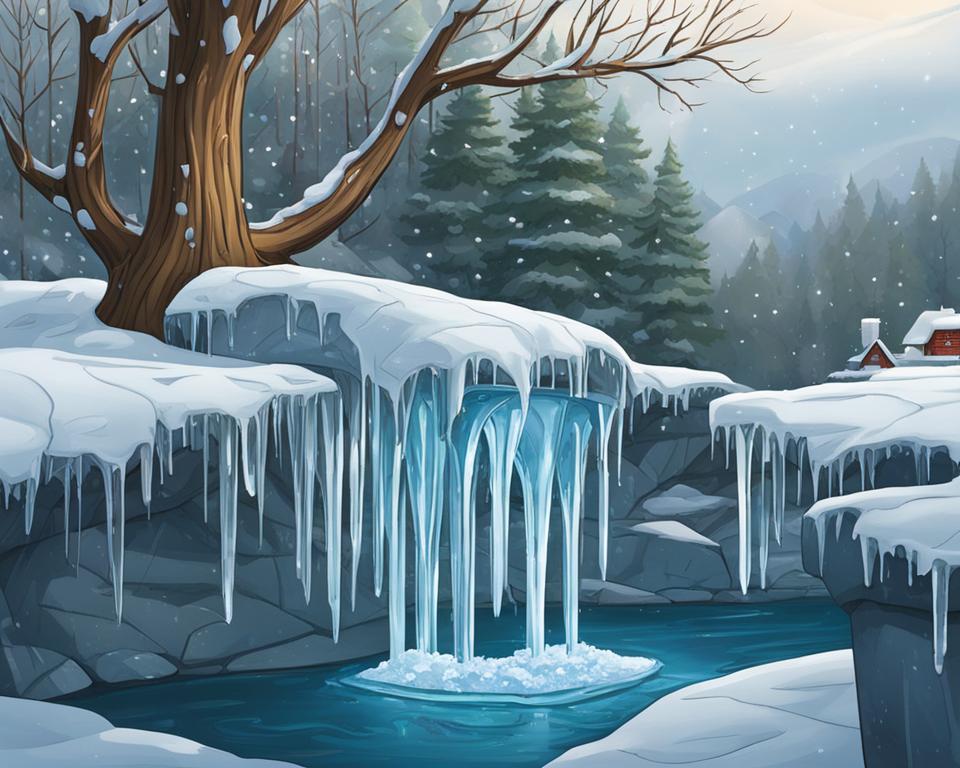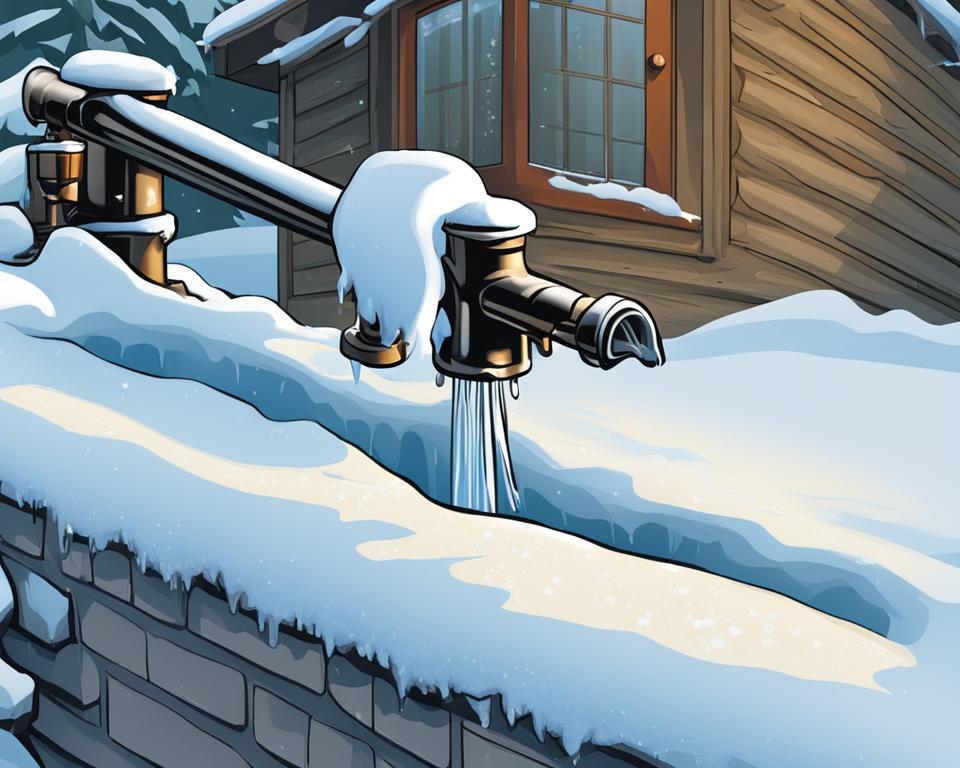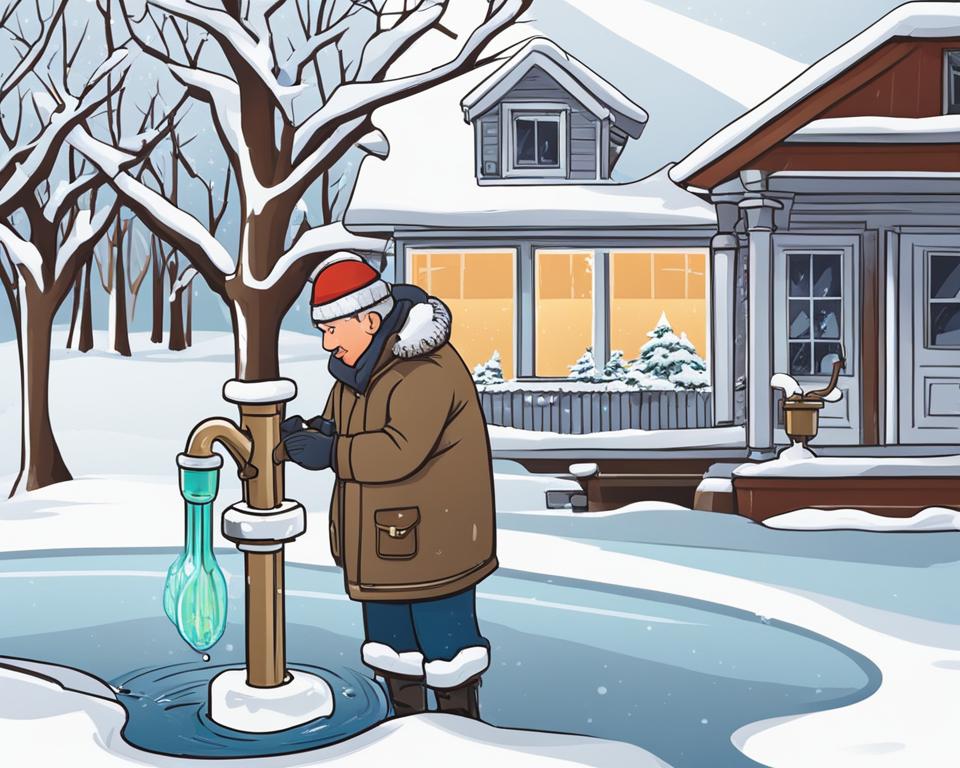Freezing outdoor faucets can lead to costly damage to your home’s plumbing system. As the winter months approach, it’s important to take steps to protect your outdoor faucets from freezing. By following these simple guidelines, you can ensure that your faucets remain functional and undamaged during the cold weather.
Key Takeaways:
- Disconnect and drain any attached hoses before winter
- Locate the control valve on the water supply pipe and turn it off
- Open the outdoor spigot to let any remaining water drain out
- Consider adding an insulated faucet cover for extra protection
- Upgrade to frost-proof faucets for better freezing prevention
Winterizing Outdoor Faucets: The Basics
When the cold weather hits, it’s essential to take proper precautions to protect your outdoor faucets from freezing. By following these simple steps, you can safeguard your faucets from the cold and prevent any potential damage.
Step 1: Remove Garden Hoses
Start by disconnecting and storing your garden hoses in a dry location. Leaving hoses attached to the faucet can trap water inside and increase the risk of freezing. Make sure to drain any residual water from the hoses before storing them away.
Step 2: Shut Off the Water Supply
Locate the control valve on the water supply pipe that leads to the outdoor spigot. Turn the handle or lever clockwise to shut off the water flow. This step is crucial in preventing any water from reaching the faucet and freezing inside.
Step 3: Drain any Remaining Water
Once the water supply is shut off, fully open the outdoor spigot to drain any remaining water. Allow the faucet to stay open until all the water has completely drained out. This ensures that there is no water left to freeze and cause damage.
Step 4: Consider Insulated Faucet Covers
To provide additional insulation and protection against freezing, consider adding an insulated faucet cover. These covers are designed to shield the faucet from the cold, reducing the risk of frozen pipes. They are available in various sizes and are easy to install.
By following these basic winterization steps, you can protect your outdoor faucets from freezing and avoid any potential plumbing issues. Taking the time to winterize your faucets will save you from costly repairs down the road and ensure your plumbing system remains in good condition.
Upgrading to Frost-Proof Faucets
If you’re looking for an effective and hassle-free way to prevent frozen outdoor faucets, upgrading to frost-proof faucets is a smart choice. These innovative faucets provide superior protection against freezing and eliminate the need for winterization. With their self-draining design, frost-proof faucets minimize the risk of freezing even in the coldest temperatures.
Unlike standard outdoor faucets, frost-proof faucets have a long rod that extends into your home, allowing the water flow to be controlled by a cartridge or compression valve. This unique setup ensures that all water is drained from the faucet, reducing the chances of freezing. By eliminating standing water in the pipe, frost-proof faucets significantly decrease the risk of damage caused by frozen pipes.
It is important to note that replacing a standard faucet with a frost-proof one requires professional installation. A licensed plumber will have the expertise and knowledge to properly install the new faucet, ensuring it is securely connected to the water supply and functioning correctly. By relying on a professional, you can have peace of mind knowing that your upgraded frost-proof faucet will provide optimal protection against freezing for years to come.
Benefits of Upgrading to Frost-Proof Faucets:
- Superior protection against freezing
- Eliminates the need for winterization
- Self-draining design reduces the risk of frozen pipes
- Increases the lifespan of outdoor faucets
- Professional installation ensures proper functionality
Investing in frost-proof faucets is a proactive measure that can save you from the headache and expense of dealing with frozen outdoor faucets. By upgrading to these advanced faucets, you can enjoy peace of mind during the winter months, knowing that your outdoor faucets are well-protected against freezing.
| Frost-Proof Faucets | Standard Faucets | |
|---|---|---|
| Protection against freezing | Highly effective | Vulnerable to freezing |
| Need for winterization | Not required | Essential |
| Self-draining design | Yes | No |
| Professional installation | Recommended | N/A |
Insulating Outdoor Faucets
Insulating outdoor faucets can provide an extra layer of protection against freezing during the winter months. The purpose-made tap covers available at most hardware stores are an inexpensive option for insulating your outdoor faucet. These covers are designed to trap a small amount of heat radiating from the house, helping to prevent freezing. Simply slip the cover over the faucet and secure it in place.
In addition to faucet covers, it’s a good idea to wrap insulation tubing around any exposed pipes leading to the outdoor faucet. This will further protect the pipes from the cold temperatures. Insulation tubing can be found at hardware or plumbing supply stores and is easy to install. Measure the length of the exposed pipe and cut the tubing to the appropriate size. Then, wrap the tubing around the pipe, securing it with zip ties or duct tape.
When insulating outdoor faucets, it’s important to ensure that the covers or insulation are properly secured and sealed. Any gaps or openings can allow cold air to reach the faucet or pipes, defeating the purpose of insulation. Take the time to check for any gaps and make sure everything is tightly sealed to maximize the effectiveness of the insulation.
By insulating your outdoor faucets and pipes, you can safeguard them from freezing temperatures and prevent costly damage to your plumbing system. Remember to remove the insulation and covers once the winter season is over to allow for proper airflow and prevent mold or mildew growth. Taking these winter precautions for outside faucets will help ensure that they are protected and ready for use when warmer weather returns.
Table: Recommended Materials for Insulating Outdoor Faucets
| Material | Description |
|---|---|
| Faucet Cover | Purpose-made cover designed to fit over outdoor faucets and provide insulation. |
| Insulation Tubing | Tubing made of foam or rubber that can be wrapped around exposed pipes to prevent freezing. |
| Zip Ties or Duct Tape | Fasteners used to secure the insulation tubing in place. |
Signs of Frozen Outdoor Faucets
Recognizing the signs of a frozen outdoor faucet is crucial in preventing further damage. Here are some common indicators to look out for:
- No Water Flow: If the faucet doesn’t turn on or only trickles water, it may be frozen. This lack of water flow is a clear sign that the faucet is experiencing freezing issues.
- Visible Ice or Frost: Inspect the faucet for any visible ice or frost. These icy formations can indicate that the faucet has indeed frozen and needs attention.
If you suspect a frozen outdoor faucet, it’s important not to force it or apply excessive heat, as this can worsen the damage. Instead, try these thawing methods:
- Use a towel soaked in hot water: Wrap the towel around the frozen part of the faucet and let it sit for a few minutes. The heat from the towel may help melt the ice.
- Pour warm water: Gently pour warm water over the frozen faucet, starting from the base and working your way up. Avoid using boiling water, as the extreme temperature change can cause the faucet to crack.
If these methods don’t work or if you’re uncertain about thawing the faucet yourself, it’s best to seek professional assistance to avoid further damage.

Expert Tip:
When dealing with a frozen outdoor faucet, it’s important to remember that prevention is key. Taking proactive measures to winterize and protect your outdoor faucets can help prevent freezing issues before they occur.
When All Else Fails: Calling a Plumber
If you’ve tried all the previous methods and are still unable to thaw a frozen outdoor faucet, it’s time to call in the professionals. Attempting to fix a frozen faucet or a burst pipe on your own can lead to further damage and costly repairs. A licensed plumber has the expertise and specialized tools to safely handle the situation and ensure a proper repair.
When you contact a plumber for help with a frozen outdoor faucet, they will assess the situation and determine the best course of action. They may use specialized equipment to thaw the faucet without causing any additional damage. In cases where a burst pipe is suspected, they will locate and repair the damaged section to prevent further leaks and water damage.
It’s important to seek professional help for frozen faucets, especially if you’re not familiar with plumbing systems. Plumbers have the knowledge and experience to diagnose the problem accurately and provide a long-lasting solution. By calling a professional, you can avoid the risk of further damage and ensure that your outdoor faucet is restored to proper working condition.
“Attempting to repair a frozen faucet or burst pipe on your own can lead to further damage and costly repairs.”
If you encounter a frozen outdoor faucet that you’re unable to thaw or suspect a burst pipe, don’t hesitate to reach out to a licensed plumber. They will have the necessary expertise and tools to safely handle the situation, preventing further damage and ensuring a proper repair. Don’t let a frozen faucet ruin your day; let the professionals take care of it!

Conclusion
Taking the necessary steps to prevent outside faucets from freezing is essential to avoid costly damage to your home’s plumbing. By disconnecting and draining hoses, shutting off the water supply valve, and adding insulation, you can safeguard your outdoor faucets during the winter months. Consider upgrading to frost-proof faucets for added protection. If you encounter a frozen faucet or signs of a burst pipe, it’s best to call a professional plumber for assistance.
Remember, outdoor faucet freezing prevention starts with simple steps like removing garden hoses and draining any remaining water. By taking these precautions, you can protect your outside faucets from freezing and potentially save yourself from expensive repairs down the line.
Winterizing outdoor faucets is a small but crucial task that can have a big impact on the overall maintenance of your home. By being proactive and following these guidelines, you can ensure that your outdoor faucets remain protected from freezing temperatures throughout the winter. Don’t let the cold weather catch you off guard – take the necessary precautions and enjoy a worry-free winter season!
FAQ
How can I prevent outside faucets from freezing?
To prevent outside faucets from freezing, start by disconnecting and draining any attached hoses. Locate the control valve on the water supply pipe and turn it off. Open the outdoor spigot to let any remaining water drain out. Consider adding an insulated faucet cover for extra protection.
Should I upgrade to frost-proof faucets?
Upgrading to frost-proof faucets is an option to consider for preventing frozen outdoor faucets. Frost-proof faucets provide better protection against freezing and eliminate the need for winterization. These faucets have a long rod that extends into the home and are designed to be self-draining. Professional installation is recommended for replacing a standard faucet with a frost-proof one.
How can I insulate my outdoor faucets?
Insulating outdoor faucets can provide an extra layer of protection against freezing. You can use purpose-made tap covers, available at most hardware stores, which trap heat radiating from the house. Additionally, consider wrapping insulation tubing around any exposed pipes for further protection.
What are the signs of a frozen outdoor faucet?
Signs of a frozen outdoor faucet include the faucet not turning on or only trickling water. You may also notice visible ice or frost on the faucet. If you suspect a frozen faucet, do not force it or apply excessive heat. Instead, try thawing the faucet with a towel soaked in hot water or gently pouring warm water over it.
What should I do if I can’t thaw a frozen outdoor faucet?
If you’re unable to thaw a frozen outdoor faucet or if there are signs of a burst pipe, it’s best to call a professional plumber. Attempting to repair a frozen faucet or burst pipe on your own can lead to further damage and costly repairs. A plumber will have the necessary expertise and tools to safely thaw the faucet and repair any damage.


